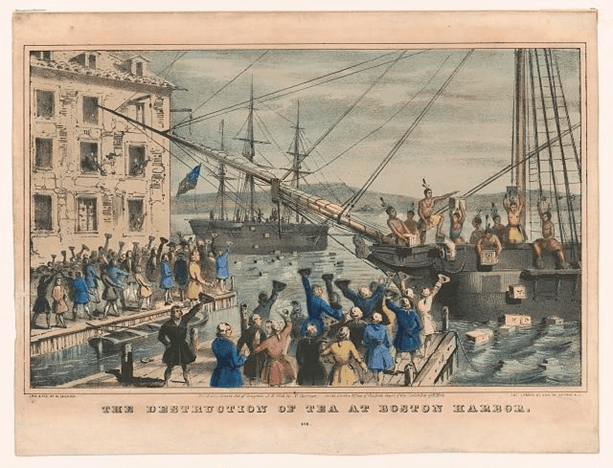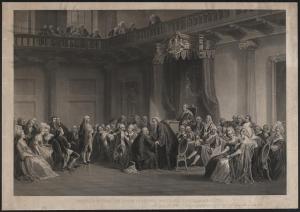In PART ONE of this blog, you learned about three men who were part of the Boston Tea Party event on December 16, 1773: Jared Joy, James Stoddard II, and Abraham Tower.

In addition to the three participants whom both Hingham and Cohasset can claim as their own, there were three other sons of Hingham involved in the Boston Tea Party: Adam Beal, Jr., Amos Lincoln, and Samuel Sprague, each of whom relocated from Hingham as young men.
• ADAM BEAL, Jr.: Age 19 on the day of the Boston Tea Party. Adam was born in Hingham on November 3, 1754. His parents, both born in Hingham, were Adam Beal (1725-1796) and Jael Worrick (also 1725-1806). When Adam Beal Jr. was born, his family lived on Hull Street in the Second Precinct of Hingham.
The Beal family in Hingham began with John Beal, “Shoemaker,” who emigrated from Hingham, England in 1638, traveling with his wife, five sons, three daughters, and two (presumably indentured) servants. John received a land grant of six acres on what is now South Street near the corner of Hersey Street. In 1659 John was chosen to represent the town at the General Court of the colony.
Adam Beal, Jr. left Hingham soon after marrying Lydia Beal, a cousin who was the daughter of Lazarus Beal, a teacher for several years in Hingham, and his wife Lydia Wheat, originally of Newton, MA. Adam and Lydia relocated to St. Albans, Franklin County, Vermont, where Adam worked as a cabinet maker. (The young couple may have briefly lived in Goshen, Hampshire County, MA, where Adam’s parents had moved, as the second of Adam, Jr. and Lydia’s sons was born in Goshen.)
In addition to his participation in the Boston Tea Party event, Adam, Jr. served multiple enlistments during the Revolutionary War, between 1776 and 1778. Adam died on July 21, 1834. He and his wife Lydia are both buried in St. Albans, Vermont.
• AMOS LINCOLN: Age 20 on the day of the Boston Tea Party. Amos was born in Hingham on March 18, 1753. His parents were life-long Hingham residents Enoch Lincoln (1721-1802) and Rachel Fearing Lincoln (1721-1782), who are both buried at Hingham Cemetery. The family (Amos was one of nine children) lived on Lincoln Street in Hingham. One of Amos Lincoln’s brothers, Levi, who later would serve as Thomas Jefferson’s first attorney general, was part of the convention that drafted the Massachusetts Constitution in 1779 and supported Quock Walker of Worcester County as he successfully sued to win his freedom from slavery citing language in that constitution.
Amos was a descendant of Samuel Lincoln, “Weaver,” who was born in Hingham England and settled in Hingham Massachusetts in 1637. The future town leader and historian Solomon Lincoln of Hingham, as well as President Abraham Lincoln of Kentucky, would therefore have been distant cousins of this participant in the Boston Tea Party.
Amos left Hingham to be a carpenter’s apprentice to Thomas Crafts, Sr. in Boston. Amos is known for marrying two of Paul Revere’s daughters: he married Deborah Revere, they had 9 children, and after her death, her sister Elizabeth Revere, with whom he had 5 children, and later Martha Howard Robb, with whom he had 3 more children. He most likely met the Revere sisters when serving in their father’s regiment during the Revolutionary War. J.L. Bell, author of the “Boston 1775” blog, wrote: “We know from Massachusetts records that Amos Lincoln served mostly close to home. He joined the state artillery regiment commanded by his master’s son, Thomas Crafts, Jr. On 10 May 1776, Col. Crafts submitted a list of officers to the state government, and Amos Lincoln was made a captain-lieutenant. He was promoted to captain in January 1778 and remained at that rank as command of the regiment passed to Lt. Col. Paul Revere in 1779.” Captain Lincoln died on the 14th or 15th of January of 1829 in Quincy, Massachusetts but is buried in Boston, at Copps Hill Burial Ground.
• SAMUEL SPRAGUE: Age 20 on the day of the Boston Tea Party. Samuel was born in Hingham on December 22, 1753. His parents were Jeremiah Sprague, “Weaver,” (born in Hingham in 1714, died “before 1778”) and Elizabeth Whiton (born in Hingham in 1718/1719, died in Hingham in 1800). Samuel’s father Jeremiah served as constable in Hingham in 1755 and 1756.
Samuel was a direct descendant of William Sprague, born in 1609 in Dorset, Upway, England, who came to the American colonies in 1629 with his older brothers, who are credited with being founders of Charlestown. William Sprague married Millicent Eames in Charlestown. After settling in Hingham in 1636 (“land was granted to him that year on ‘the Playne’”) they lived on Union Street “over the river.” This would be the paternal homestead for generations to come. William served Hingham as a Selectman and as a town constable.
Samuel Sprague served in the Revolutionary War in the artillery company of Maj Thomas Pierce. Samuel was a mason by trade and it likely was work that first brought him to Boston from Hingham. He married Joanna Thayer, of Boston, a daughter of Obediah Thayer, born in 1756 in Braintree. The Spragues became most well-known for their fourth son, Charles Sprague, who was a famous poet in the nineteenth century, at times referred to as the “The Banker Poet of Boston.” They lived in a house on Orange (now Washington) Street.
In his book “Tea Leaves,” which provides considerable detail about the Boston Tea Party, Francis S. Drake (1828-1885) includes an account that Samuel Sprague reportedly shared with his son regarding the tea dumping event of December 1773:
“That evening…I met some lads hurrying along towards Griffin’s wharf…I joined them, and on reaching the wharf found the “Indians” busy with the tea chests…I obtained a quantity of soot, with which I blackened my face. Joining the party, I recognized among them Mr. Etheredge, my master. We worked together, but neither of us ever afterwards alluded to each other’s share in the Proceedings.”
Samuel Sprague died June 20, 1844.

He is buried in the Central Burying Ground, on Boston Common off Boylston Street (as is his son the poet) in the Sprague family tomb, Number 5—gravesite shown here. His wife Joanna died a few years later—in 1848.
I came across a fun Hingham history-related story about Samuel and Joanna’s son Charles, the poet. There is a collection of Sprague family papers in the Hingham Public Library archives, collected and donated by John Richardson. Among the items archived in the collection is a letter from poet Charles Sprague written in 1835, to Jairus Lincoln, stating that he will be unable to write an ode for Hingham’s Bicentennial Celebration, as had been requested of him.
Were there any consequences for those who participated in the Boston Tea Party?
One important aspect about Hingham at the time of the Boston Tea Party, and throughout the Revolutionary War, is that there were residents who were Loyalists, faithful to the King of England, living alongside the Patriots fighting for independence. Jotham Gay, whose letter I referenced earlier, was not alone in expressing disapproval of the “destruction…of private consignments” of tea. Reportedly, George Washington thought the protestors, whose concerns about taxation he agreed with, had gone too far in dumping the tea, and that they should compensate the East India Company for the damages. But at the time, many of those involved fled from Boston, and their identities were kept secret.
Others of our founding fathers disagreed. John Adams wrote in his diary, “This destruction of the tea is so bold, so daring, so firm, so intrepid and inflexible, and it must have so important consequences, and so lasting, that I cannot but consider it as an epoch in history. The question is whether the destruction of the tea was necessary? I apprehend it was absolutely and indispensably so…. To let it be landed would be giving up the principle of taxation by Parliamentary authority, against which the continent has struggled for ten years…. But it will be said, it might have been left in the care of a committee of the town, or in Castle William. To this many objections may be urged.”
Benjamin Franklin wrote the following, from London, to the Honorable Thomas Cushing on March 22, 1774 concerning potential legal consequences for those involved in the dumping of tea at Boston:

Franklin before the lord’s council, Whitehall Chapel, 1774; painted by C. Schuessele, engraved by Whitechurch. Digital file from Library of Congress.
A footnote to this letter on Founders Online adds that when witnesses from Boston were interrogated—presumably, the “enquiries” to which Benjamin Franklin refers—the law officers decided that such testimony did not provide sufficient evidence for a charge of high treason. “Only one member of the Sons of Liberty, Francis Akeley, was caught and imprisoned for his participation.” A partial listing, of 58 of those involved in the Boston Tea Party, was published decades later, in 1835–after many of the protestors had died.
And here we are, in 2020, a year of many challenges, when protest and activism by citizens of all ages has been a constant throughout our nation.
I will end this blog by noting that December 16, 2023 will be the 250th anniversary of the Boston Tea Party. But I am not waiting to celebrate these young activists of their day. When this year’s 247th anniversary arrives, I plan to brew a pot of tea and have a high tea salute to our six Hingham Sons of Liberty!
______________________________________________________________________________
REFERENCES for this blog post (parts one and two) include:
PATRIOT LEDGER, November 4, 2019, article by Sue Scheible; The 1893 History of Hingham, published by the Town of Hingham; the 1827 History of Hingham by Solomon Lincoln; article on the Boston Tea Party by MABEL PRATT Registrar, Col Thomas Lothrop, DAR, AMERICAN MONTHLY MAGAZINE March 1901; http://www.Founders.archives.gov (Founders Online repository); the Boston Tea Party Museum website, the Library of Congress online archives; Tea Leaves, Being a collection of letters and documents relating to the shipment of tea to the American colonies in the year 1773, by the East India Company, by Francis S. Drake, 1884; Out of the Archives, the Hingham Historical Society’s blog; the Gay family papers at the Hingham Historical Society; the work of J. L. Bell on Boston 1775, on-line articles provided by the History Channel; various family histories available on Ancestry, the Plymouth Colony Pages, and other genealogy websites. I also benefitted from the insights, suggestions, and access to items in the Hingham Historical Society collection provided by Ellen Miller (who, in addition to her work for the Old Ordinary House Museum, is involved, with Susan Wetzel, in a collaborative Hingham Historical Society/DAR project to identify Hingham men connected with the Revolutionary War) and by Hingham Historical Society Collections Manager and Registrar, Michael Achille.
[…] a Revolutionary War Patriot who also participated in the Boston Tea Party, as discussed in a 2020 post on this blog. Samuel’s pension states that he crossed the Delaware with George Washington! […]
[…] the importance of recognizing how climate change affects archival practice, the Hingham Archives wrote about the Boston Tea Party and citizens of Hingham who attended, and the Religious Collections section of […]